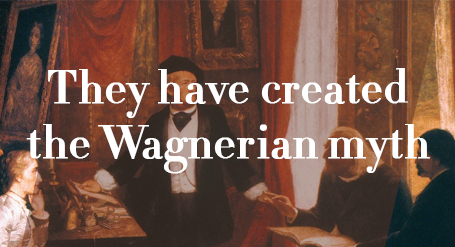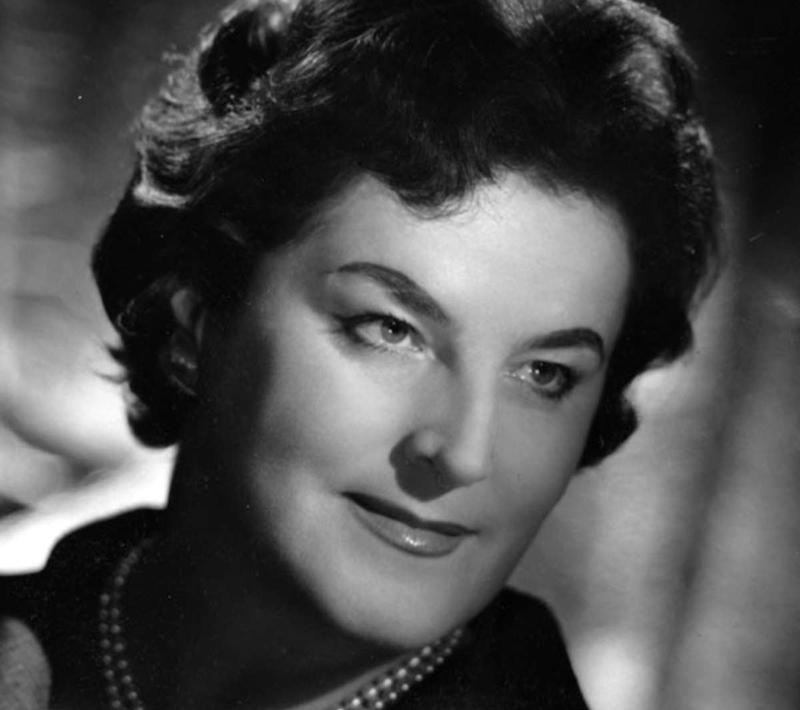
If Wagner was the cultural and musical chronicler of his time, if he remained a revolutionary activist, he had also gone into the act of police, and if he was finally his master of Bayreuth celebrated as the one of the major artist of his At the time, the illustrious composer did not live before a man made of chair and blood, animated by passions, with a sometimes violent, sometimes facetious, and sometimes tender character.
NILSSON Birgit (Märta Birgit Svensson)
(born on 17 May, 1918 – died on 25 December, 2005)
Swedish opera singer (dramatic soprano)
An incomparable, unforgettable artist, one of those rare “stage performers” being able to sing Isolde one evening, and Brünnhilde, the folowwing one ! Everytime with the same energy and talent. And enthusiasm. Birgit Nilsson left of her immense talent testimonies on discs that, even today, are a reference. This one of the most famous dramatic sopranos of her time embodied, often with her stage companion Wolfgang Windgassen, the revival of the art of the Wagnerian singing that marked the Wagnerian scene of the sixties, in Bayreuth and in the biggest opera house stages of the world. Of a solid Nordic stature and powerful voice, Birgit Nilsson had an extraordinarily rich repertoire (for so-called “new generation” singers); she simultaneously performed major roles of Verdi, Puccini, Wagner and Richard Strauss. Affectionately nicknamed “La Nilsson” or “Miss N.”, Birgit Nilsson’s talent and career still commands admiration from any music lover.
Birgit Nilsson – whose real name was Märta Birgit Svensson – was born in a modest family, her parents being simple owners of a farm located about a hundred kilometers north of Malmö. Very soon, the child was indescribably appealed by music; she later confided in an interview that she knew how to sing even before she could walk! Music was omnipresent in the life of the girl who couldn’t stop singing “even while sleeping, in her dreams”. Her vocal qualities were quickly recognized and taken seriously when she joined the choir of the small church in her provincial parish. The choirmaster advised the parents of the little Märta Birgit to have her take singing lessons.
Particularly assiduous, the young woman worked tirelessly to prepare for the audition of the Royal Academy of Music of Stockholm’s singing competition. She was received first out of forty-seven participating singers. She adopted, from the beginning of her studies at this very renowned school, the stage name of Birgit Nilsson. Her best teacher: herself as she would always reiterate thereafter. Some of her first teachers, undoubtedly disconcerted by the power of the vocal instrument the young artist had at her disposal, would have almost destroyed her most precious possession that she cherished and polished day after day with as much patience as prudence.
But it was necessary to decide one day to climb on stage. Which is what Birgit Nilsson did on 9 October, 1946, by replacing on short notice the singer who was playing the role of Agathe – that she did not know and had to learn in less than three days – in Der Freischütz by Weber. This first performance was not enough to decide the career of the young artist despite the rave reviews from the press and it was not until the following year, in October 1947, that she attracted the public’s attention in her performance of the terrible Lady Macbeth in Verdi’s opera, under the direction of the eminent Fritz Busch at the Stockholm Opera. The soprano then was not even thirty years old.
Stockholm is like most European theatres of the time a “repertoire” house where one sings in the language of the country, in this case, in Swedish – from Verdi to Wagner, through Puccini or even Mozart, Tchaikovsky or Richard Strauss. On 26 February, 1948, she was offered the role of the Marschallin in Strauss’s Rosenkavalier, a role that Nilsson appreciated tremendously and that, she lamented, was never offered to her again. She thus could only play the character of Richard Strauss in Stockholm… and in Swedish! But this role enabled her to join the Stockholm Opera troupe. She then even performed the roles of Venus, Sieglinde and Senta.
Her understanding with Fritz Busch was immediate and so spontaneous that the conductor did not hesitate to bet on the young soprano and this decided the artist’s international career, despite her marriage with Bertil Niklasson, a young man who was studying to become a veterinarian, on 10 September, 1948.
Her first international appointment was at the Glyndebourne Festival in the summer of 1951 in the role of Elettra from Mozart’s Idomeneo, a role full of ardour, a volcano that revealed the artist to the world. The German public immediately asked for her: in 1953 Birgit Nilsson opened the third Festival of the New Bayreuth by playing the soprano in Beethoven’s Ninth Symphony and making her debut on the stage of the prestigious Staatsoper in Vienna. Nilsson returned to Bayreuth the following summer, in the role of Elsa in Lohengrin. But it was the United States in particular that revealed the hugeness of the singer’s talent and made her a real star. After making her debut in the role of Brünnhilde (The Valkyrie) in 1956 at the San Francisco Opera, then – still on short notice – in the role of Isolde at the Met in New York, in 1959, Birgit Nilsson was from then on in demand and acclaimed on all the operatic stages in the world: Vienna naturally, but also Berlin, Paris, Covent Garden in London, Buenos Aires, Chicago, Hamburg as well as Sydney and Tokyo.
And Bayreuth, naturally, Richard Wagner’s Holy Temple, where she played an Isolde for Wolfgang Wagner alongside Windgassen during the summer of 1957, then a Sieglinde of transcendent fire for the brother, Wieland, before being Wotan’s daughter, Brünnhilde, thus succeeding legitimately to Astrid Varnay.
Multiplying the performances on stage, Birgit Nilsson was THE star of the Met by giving over two hundred performances, covering no fewer than sixteen roles. Likewise for the Vienna Staatsoper: two hundred and thirty-two performances, most of which were devoted to the Wagnerian and Straussian repertoire.
Another exceptional event for her, she was invited in 1966 for a rather unusual performance at the Metropolitan Opera: she was given the two female roles in Tannhäuser, Venus and Elisabeth. She retired in 1984, much to the despair of her admirers!
A personality brimming with humour and never resisting the chance to tell the many anecdotes she gathered in an autobiography that became famous afterwards, Birgit Nilsson wasn’t any less of a shrewd businesswoman. That is how she was noticed as one of the best-paid artists of her generation. When she died in 2005 at eighty-seven years of age, having never had children, the artist bequeathed her (colossal) fortune to a foundation (The Birgit Nilsson Foundation) earmarked to reward the best artists (singers, conductors, directors, musical ensemble or opera production) in activity. She had already created a “Birgit Nilsson Scholarship” in 1969, awarding up to 100,000 Swedish kronors, but the “Birgit Nilsson Prize” is the current most important classical music award: 1 million U.S dollars reward every two to three years the exception. After awarding Placido Domingo (2009) and Riccardo Muti (2011), the latest one (2014) was awarded to the Vienna Philharmonic Orchestra. The Orchestra declared that it wanted to devote this sum to digitizing all its archives and making them available to the public free of charge. Even after her passing, the artist continues to keep opera alive for the benefit of all.
NC
If you wish to share further information about this article, please feel free to contact us !
